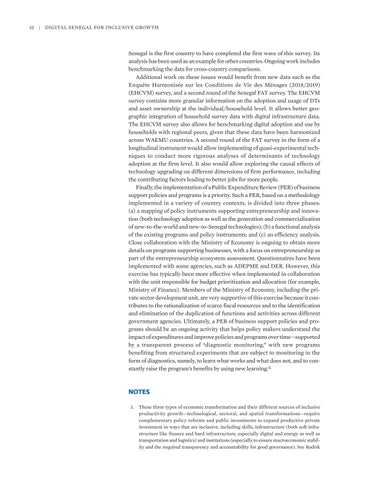32
| Digital Senegal for Inclusive Growth
Senegal is the first country to have completed the first wave of this survey. Its analysis has been used as an example for other countries. Ongoing work includes benchmarking the data for cross-country comparisons. Additional work on these issues would benefit from new data such as the Enquête Harmonisée sur les Conditions de Vie des Ménages (2018/2019) (EHCVM) survey, and a second round of the Senegal FAT survey. The EHCVM survey contains more granular information on the adoption and usage of DTs and asset ownership at the individual/household level. It allows better geographic integration of household survey data with digital infrastructure data. The EHCVM survey also allows for benchmarking digital adoption and use by households with regional peers, given that these data have been harmonized across WAEMU countries. A second round of the FAT survey in the form of a longitudinal instrument would allow implementing of quasi-experimental techniques to conduct more rigorous analyses of determinants of technology adoption at the firm level. It also would allow exploring the causal effects of technology upgrading on different dimensions of firm performance, including the contributing factors leading to better jobs for more people. Finally, the implementation of a Public Expenditure Review (PER) of business support policies and programs is a priority. Such a PER, based on a methodology implemented in a variety of country contexts, is divided into three phases: (a) a mapping of policy instruments supporting entrepreneurship and innovation (both technology adoption as well as the generation and commercialization of new-to-the-world and new-to-Senegal technologies); (b) a functional analysis of the existing programs and policy instruments; and (c) an efficiency analysis. Close collaboration with the Ministry of Economy is ongoing to obtain more details on programs supporting businesses, with a focus on entrepreneurship as part of the entrepreneurship ecosystem assessment. Questionnaires have been implemented with some agencies, such as ADEPME and DER. However, this exercise has typically been more effective when implemented in collaboration with the unit responsible for budget prioritization and allocation (for example, Ministry of Finance). Members of the Ministry of Economy, including the private sector development unit, are very supportive of this exercise because it contributes to the rationalization of scarce fiscal resources and to the identification and elimination of the duplication of functions and activities across different government agencies. Ultimately, a PER of business support policies and programs should be an ongoing activity that helps policy makers understand the impact of expenditures and improve policies and programs over time—supported by a transparent process of “diagnostic monitoring,” with new programs benefiting from structured experiments that are subject to monitoring in the form of diagnostics, namely, to learn what works and what does not, and to constantly raise the program’s benefits by using new learning.31
NOTES 1.
These three types of economic transformation and their different sources of inclusive productivity growth—technological, sectoral, and spatial transformations—require complementary policy reforms and public investments to expand productive private investment in ways that are inclusive, including skills, infrastructure (both soft infrastructure like finance and hard infrastructure, especially digital and energy as well as transportation and logistics) and institutions (especially to ensure macroeconomic stability and the required transparency and accountability for good governance). See Rodrik



